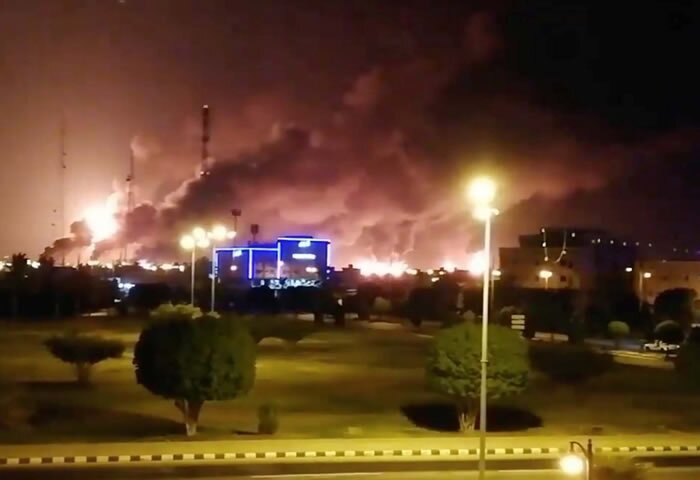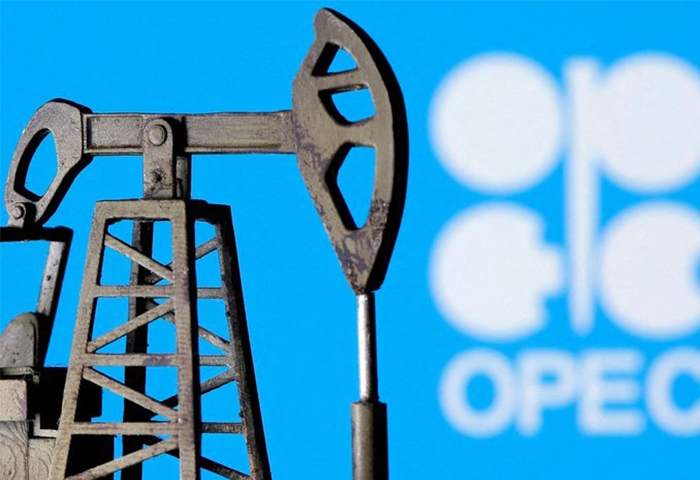Drone attacks on key Saudi oil facilities have halved crude output from OPEC's biggest exporter, catapulting oil prices by the largest amount since the first Gulf War. The crisis has focused minds on unrest in the crude-rich Middle East, with Tehran denying Washington's charge that it was responsible.
Here is a breakdown of winners and losers from runaway oil prices and Saudi unrest.
Is Saudi Arabia the biggest loser?
The attacks on national energy giant Saudi Aramco's Abqaiq processing plant and Khurais oil field knocked 5.7 million barrels per day off production, more than half of its total output. Riyadh, which depends on its oil sector to lift revenues, is the de facto leader of the 14-nation Organization of the Petroleum Exporting Countries (OPEC).
Soaring world oil prices traditionally boost the coffers of OPEC nations – but most experts contend that Saudi will most likely not benefit this time.
Saudi authorities have considered whether to delay an initial public offer of Aramco shares, but, it has been decided that the company will make its long-awaited debut on the Riyadh stock market on December 11. The Saudi exchange will announce a timetable for the initial public offering including the release on November 17 of the targeted share price.
The IPO forms the cornerstone of a reform program conceived by the kingdom's de facto ruler Crown Prince Mohammed bin Salman to wean the Saudi economy off its reliance on oil. Saudi Arabia was hoping that the company is evaluated at $2 trillion so its proposed sale of five percent of its share would generate the desired $100 billion. But reports said that the valuation came in lower than that. After the listing on the domestic stock exchange, Aramco is believed to be planning to sell the rest of the five percent on an international bourse.
But this attack which is claimed by the Huthis, with whom the Saudis have been at war in Yemen for the last few years, raises many questions about the kingdom’s ability to protect its own facilities, not to mention the billions paid for US defense which proved to be useless. In fact, Russia took the opportunity to offer the Saudis its S-400 missiles defenses system.
James V Moore Jr., CEO of the US-based Washington Institute for business, government and society talks about the situation of Saudi Arabia and the oil attacks. “It is audacious, the fact that the linchpin of Saudi infrastructure could get hit like this”, he says. “It was quite amazing. It was choreographed in such a way to have spokesman from Yemen standing up and saying that they were the ones responsible for it when it now appears from all intelligence that was not only Iranian-directed and came from Iranian soil. The notion that billions of dollars have been spent on the defense of Saudi Arabia to avoid this sort of things happening certainly has been concerning on everybody’s part. And what happens next is anybody’s guess.”
OPEC and Russia
OPEC, whose 14 member nations together pump just under one third of the world's oil, are already seeking to curb supplies and lift prices.
The cartel in July signed a new charter of cooperation with major allies including Russia as they agreed to prolong daily production cuts. The Saudi drone attacks could boost producers with spare capacity – yet also exposes simmering tensions between Riyadh and Tehran.
“Other OPEC producers will benefit more – and non-OPEC, notably Russia,” said independent economist Julian Jessop. “But location still matters. Anyone dependent on shipping their oil or gas via the Straits of Hormuz may also find their markets cut off if tensions do escalate. Countries with spare capacity will benefit the most, but even those producing at capacity will be able to sell their oil for a higher price.”
United States: The biggest winner perhaps?
The United States should reap the benefits due to its status as the world's biggest oil producer on booming shale oil.
“This means that the US shale industry will directly benefit ... and it will be interesting to see how quickly additional barrels can be brought onto the market from the US,” said JBC Energy analysts. “However, this question is – at least for the next couple of months – less one of actual production, but much more one of logistics. We would expect a surge in US crude exports over coming months.”
In order to cushion the market impact, US President Donald Trump authorized the release of oil from US strategic reserves.
According to the US Energy Information Administration, the world has 4.1 billion barrels of oil in storage. 1.4 billion is held by governments, while the rest is held by oil companies and trading houses. The United States has the capacity to hold 722 million barrels and China has a store of almost 500 million barrels.
Just two days after the attacks in Saudi Arabia, Jason Kenney, the premier of the Canadian oil-producing state of Alberta, tweeted, “Alberta is the most secure major source of energy on Earth … The strike on Saudi refineries should be a wakeup call. The world needs reliable, stable energy, and Alberta can provide it.”
US producers have also emphasized the “safety” of their operations and signaled the potential for more growth in the aftermath of the Aramco attacks. Despite the recent negative tendencies in its shale oil industry, such as the weakening growth of production in the Permian basin caused by emerging operational bottlenecks, the US is still slated to become a net exporter of oil for the first time in recent history later this year.
Iran reprisals
Tehran, which has already been slapped by US sanctions, stands accused by Washington of being behind the attacks.
Trump has already threatened action against the Islamic republic, warning that the US was “locked and loaded” to respond.
The arch-enemies remain in a tense standoff since the US in May 2018 unilaterally pulled out of a multilateral accord that limited the scope of Iran's nuclear program in exchange for sanctions relief.
The escalation has been accompanied by ships being mysteriously attacked, drones downed and oil tankers seized in the Strait of Hormuz – a chokepoint for a third of the world's seaborne oil.
World economy
The global economy, which is suffering from a sharp slowdown amid the China-US trade war, is likely to take a hit from soaring oil prices, analysts say.
The commodity is regarded as a key barometer of growth because it greases the wheels of the world economy and is vital to most economic activity.
Runaway oil prices meanwhile feed through into higher consumer prices and risk stagflation, whereby they suppress growth yet fuel inflation.
“The attack on Saudi oil is unlikely to be a disaster for the global economy,” said Jennifer McKeown at Capital Economics. “But growing tensions in the Middle East are another headwind for the global economy in already uncertain times, and a full-blown conflict could trigger another leg in the global downturn.”
Blow for China
China, which remains entangled with the United States in a trade war, is also expected to suffer due to its oil-dependent and energy-hungry economy.
The Asian powerhouse, whose growth is faltering, is also struggling with spiking inflation and a badly performing manufacturing sector. Yet oil demand is already waning in the face of weaker growth.
“While some are forecasting an imminent jump in crude oil prices to $100, we see less upside risk than that,” said Prestige Economics analyst Jason Schenker. “After all, the global economy has slowed sharply, and China as well as Europe are in the midst of manufacturing recessions.”
How serious is the attack?
Saudi energy infrastructure has been hit by the Huthis many times before, but this strike is of a different order, forcing the state-owned oil giant Aramco to temporarily suspend about half of its total output. The significant drop in the output of the world's second-biggest oil producer led some analysts to speculate that oil prices would surge to well over $70 per barrel and settle around that mark for an extended period of time. This, however, did not happen. The spike in prices was temporary and the barrel price fell below $60 shortly after.
Fortunately, Saudi Arabia was able to calm the markets very quickly after the internal change as to the energy minister to reassure the markets that they would be back online very shortly.
The petrochemical industry was also affected by the attacks, but it, too, managed to recover rather quickly. Saudi Arabia, which is the world's leading producer of ethylene, polyethylene, and monoethylene, announced that there would be only short-term disruptions of product deliveries, with delays expected in October.
Saudi Arabia was quick to stave off an oil crisis by compensating for the partial loss of output with its own reserves and by giving assurances that export commitments will be met. However, there’s a need to watch out for any future incidents that could create chaos.
Although Saudi Arabia managed to stabilize the situation quickly and compensate for the damage done to its oil infrastructure, the September 14 attacks could still have a negative long-term effect. Much of it has to do with consumers' concerns about the possible repetition of such an attack. Consumer behavior is mainly driven by perceptions and expectations – whether well-grounded or not - and it does not always conform to the rules and logic of economics.
Much of the world now sees that the drone attacks on key oil facilities demonstrated that the Saudi oil and petrochemical complex is facing a new type of security threat. It is now conceivable that major damage and disruption can be done with relatively cheap and easy to obtain weapons which can defeat sophisticated air defense systems.
Drones or maybe cruise missiles travelled 500 km across Saudi territory undetected to strike at the heart of its oil industry and to knock out 5% of the world’s oil supply. The fear of another attack could affect oil prices every time the crisis in the Gulf escalates and the risk of another regional confrontation spikes. It could also compel some buyers to decrease their reliance on oil purchases from Saudi Arabia and the region as a whole and encourage them to secure alternative suppliers.
Why can't Saudi stop these strikes?
Saudi Arabia has splurged billions on military hardware including advanced fighter jets. But its arsenal has proved ineffective against the Huthis, a ragtag but highly motivated tribal militia that specializes in hit-and-run guerrilla tactics.
Recent developments have also highlighted the potent threat posed by the Huthis' steadily advancing weaponry, from ballistic missiles to unmanned drones.
While the kingdom's oil wells, scattered over a vast geographical area, may be a difficult target, its various oil processing facilities are much more exposed. The Abqaiq facility is the “most vulnerable” among them, according to the Washington-based Center for Strategic and International Studies.
Aramco's vast system of pipelines, pumping stations and ports along the Gulf and Red Sea are also at risk. A drone attack on two oil pumping stations in May forced a days-long shutdown.
The Saudi authorities recognize this danger and have already taken some measures. They have prioritized the implementation of contract obligations with Asian buyers of petrochemical products. However, such measures might not be enough in the long term. If Saudi Arabia wants to keep its positions on the oil market, it will have to take much more drastic measures to reassure buyers.
It will have to boost the defense of its oil infrastructure and demonstrate its effectiveness in staving off another attack. It will also have to shift supply routes away from the bottleneck of the Strait of Hormuz, which Iran has repeatedly threatened to close. Currently, about 90 percent of its oil exports pass through the strait; if their passage ever gets disrupted, this could cause a much bigger shock to energy markets.
The September 14 attacks should be a wakeup call for Saudi Arabia. Their long-term effects could have a serious impact on its economy. It needs to act quickly and decisively so it does not lose its position on the global market and with that, a major source of funding for its Vision 2030.









